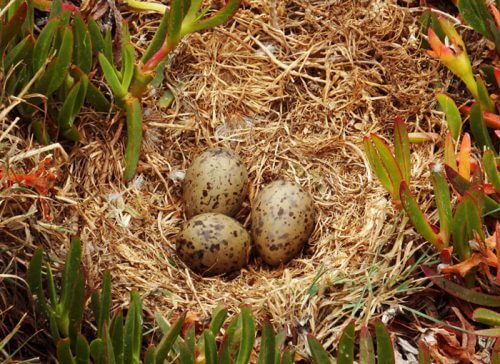Embryos of seagulls who heard the warning of the chicks and adults are able to pass it on to their brothers, who have also not yet hatched from the egg.

The nesting colony of the yellow-legged gulls (Larus michahellis) on the island of Salvora (Sálvora) off the coast of Spain is relatively peaceful, as peaceful as a colony of thousands of gulls can be. But suddenly, above the chirping of the chicks and the flapping of the wings of the adults, a loud call is heard: Ha! Ha! Ha! More seagulls join her, and soon the whole colony knows: an American vison (Neovison vison), a predator that especially likes eggs and chicks, has been spotted in the nesting grounds.
The chicks that hear the warning call lie down on the ground and remain there motionless, but this call does not only affect them: it even reaches the ears of the embryos that are still in the swamp. study that was published about a year and a half ago showed that chicks that were exposed to the warning calls while in the egg responded to them faster after hatching. Now the researchers show In a new study Because the embryos who heard the warning are able to pass it on to their brothers, who have also not yet hatched from the egg.

pass it on
Several studies in recent years have shown that bird embryos, which are still developing in eggs, are attentive to what is happening outside. Songbird chicks, for example, begin to learn the characteristic song of their species before they hatch, and research has shown that zebra finches passing on information to their descendants on the temperature in the area, and the chicks change their growth rate accordingly.
In the new study, the researchers wanted to check if the messages can also be passed between those passing by in the same taluk. For example, if one of the chicks hears a warning call, he can then pass the information on to his younger brother, who may not yet be at an advanced enough developmental stage to hear and respond to the call.
To test this, the researchers collected 90 eggs from the colony on Salbora Island, about a week before they were supposed to hatch, and transferred them to the hatchery, stored in groups of three. Each day they took two of the eggs and placed them in a soundproof box where, for several minutes, recorded warning calls of seagulls were played. After that, they were returned to the "nest", and placed again next to the third egg, which always remained in the hatchery and was not exposed to readings at all. As a control, some of the groups of eggs went through exactly the same process - every day two of them were taken to a sealed box and returned after a few minutes - but without the warning calls.
When the chicks hatched, the researchers found that the chicks in the groups exposed to the warning calls differed in their behavior and physiology from the chicks in the control groups. They hatched later than the control chicks and also grew more slowly. Their blood had more hormones associated with stress and anxiety, and they responded faster to the warning calls. The differences were visible even before they hatched: the chicks in the groups that heard the calls made fewer chirps from the egg.
The most interesting finding is that all these differences were also seen in the chicks whose eggs remained in the hatchery, and only their group mates were taken to the box where the warning calls were heard. Without hearing a single call, these chicks adapted to life in a colony threatened by predators, just like their brothers who heard the calls. How did they know to do this? The researchers speculate that they learned this from the eggs they had with them in the "nest".
"It's completely unexpected," said Kevin McGowan, an ornithologist who was not involved in the study. In an interview with the New York Times. "It's one thing if everyone receives the same information - if they hear the same thing and react the same way. But this research indicates that the bird embryos that are a day or two ahead of their siblings can pass on what they have learned to them."
Listen to the vibrations
How do the embryos manage to "talk" to each other when they are inside the eggs? Apparently, with the help of their shaking. When seagull embryos hear the warning calls, they start moving inside the egg in a certain way, which causes the egg to shake. During the experiment, these tremors were indeed more common in groups where two of the eggs were exposed to warning calls. The researchers hypothesize that the vibrations are at least part of the mechanism by which the information passed from the "experienced" eggs, which heard the calls, to the egg that did not hear them.
Later, the researchers intend to examine more deeply the transfer of information between the eggs, and check if they can learn with its help not only about the presence of predators, but also about the condition of their siblings: who is stronger, who will hatch sooner, and more. Such information could help them prepare for sibling competition for food after hatching. "If the embryo is able to absorb information about the environment, it can be assumed that it will also be able to absorb information about the siblings, or the competitors, who are about to hatch," said Jose Noguera, who led the study. In an interview with Scientific American. "This way they will be able to follow the development of their brothers, to adapt their own development to the future competition."
More of the topic in Hayadan:
For science updates from the Davidson Institute website on the Telegram channel או At watsap
